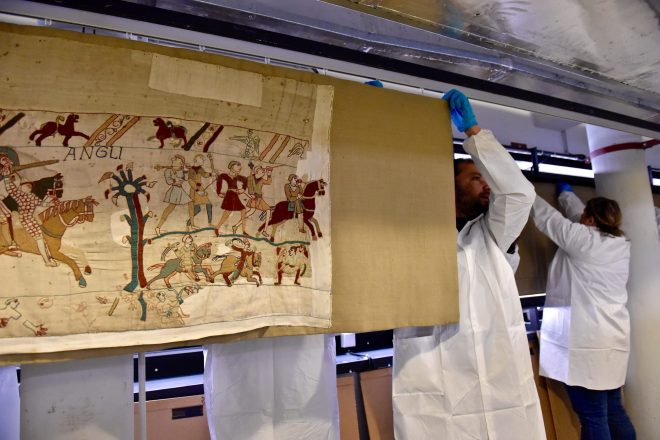
Share
There have already been several analyses of the way in which the Bayeux Tapestry is currently displayed with regard to preventive conservation (ten-yearly monitoring, climatic and lighting studies, accumulation of dust, scientific imaging campaigns etc). In 2020 the DRAC de Normandie, a decentralised department of the Ministry of Culture, assisted by the Fabrique de patrimoines en Normandie (Normandy Heritage Workshop), was able to initiate a preliminary study of the embroidered face of the work. The results of this study are serving to determine the actions required to stabilise the work and they call for an analysis of the way it is displayed. They will also feed into the deliberations on the architectural and museographical project that is being drawn up.

During the annual period when the museum was closed, The Bayeux Tapestry was meticulously handled by experts in order to provide direct access to the work without the interface of its glass case. A team of eight restorers-curators specialising in textiles was recruited by the DRAC Normandie for the purpose of carrying out an examination of the linen cloth, centimetre by centimetre along its entire length of 68.38 metres, in the space of less than a month. Each day, the points of deterioration found were transferred directly on to the digital SIDS tool (developed by the University of Caen and the CNRS), with the entries made using a digital tablet provided to each restorer.

Some of the points of deterioration bear witness to the history of the work, and so will be conserved unless they represent a risk of further damage to it. For example, nail holes from the Tapestry being hung, repairs to the cloth and even wax stains caused by the candles used to light the cathedral have all been found. In the context of the museum renovation project, the scientific committee concluded that restoration of the work would be necessary to stabilise the state of the deteriorations and to ensure better future conservation.
In the context of the museum renovation, the DRAC Normandie is currently in the process of commissioning a study in order to determine how to remove the work from its current position and the conditions in which the restoration can be carried out, and at the same time what the specifications should be for a new showcase in which to display the work. The new showcase needs to enable the conservation and display conditions of this medieval masterpiece to be optimised in its new setting.